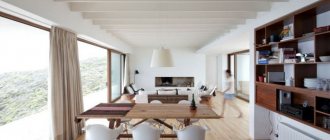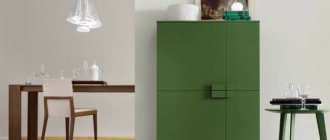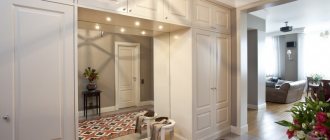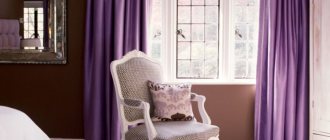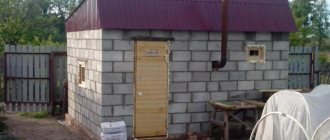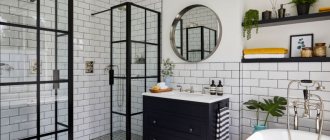04/18/2016 master
Today, a variety of lighting devices allow you to create the most unique and non-standard lighting options in the house. One of the most popular lighting options, which is used for plasterboard and suspended ceilings, is spot lighting.
The variety of building materials, as well as the ability to realize all your fantasies in suspended ceiling structures, allows you to create lighting in a unique way for each room in the house. This article will tell you how to make spot lighting for the ceiling with your own hands, and what the features of these lighting devices are.
Design Features
Suspended ceiling
Suspended ceilings are very popular today. They are the easiest place to organize lighting of any type. The design of the ceiling itself can be made of several materials:
- drywall;
- stretch fabric made of PVC film;
- plastic.
The popularity of such designs is based on the following advantages:
- the ability to hide uneven starting surfaces;
- ease of installation according to a given scheme, thanks to which all installation work can be done with your own hands;
- the ability to choose a variety of ways to illuminate the room.
Note! For suspended ceiling structures, it is necessary to choose light-weight lighting fixtures. In this situation, spot lighting would be an excellent solution, since here small lamps will be placed over the entire ceiling surface without creating strong pressure in a specific area. This is especially true for stretch and plasterboard ceilings.
Features of lamps
Zoning
The popularity of spot lighting is gaining momentum every year. This is due to some features of such lamps. The main features of spotlights when organizing indoor lighting are:
- the ability to provide visual zoning of the room into separate zones. This is the simplest, fastest and cheapest way to functionally divide a room into certain zones;
- such lighting can create high-quality and effective lighting in any room of the house;
- the possibility of creating a lighting system in which the lamps will illuminate a certain local area of the room;
- creating the necessary atmosphere in the house (from festive to romantic);
- creating decorative lighting for individual ceiling elements.
As you can see, using this type of lighting gives you a lot of scope for creating complete lighting.
Characteristics of lamps
Spotlights, unlike other lighting devices, have a number of design features. A spot lighting device looks like a small lamp that should be installed in a suspended ceiling structure. This allows you to place the devices flush with the ceiling surface, making them protrude minimally beyond the ceiling.
Spotlight
A slightly protruding part of the lamp in the form of a lampshade is allowed. This is relevant in a situation where the lampshade has a beautiful appearance and can act as a decorative element. Note! Full lighting when using spotlights will be achieved only with the simultaneous placement of several lighting elements. At the same time, it is very important to correctly place them on the ceiling canvas. It should be remembered that the choice of lighting elements depends on the type of ceiling structure. For example, for a plasterboard ceiling, the lamp is taken with spring fasteners, and for a tension ceiling - with other types of fasteners. This must be taken into account if the ceiling and lighting will be made by hand. The principle of installing lamps for plasterboard ceilings is to insert the device into a hole prepared in advance and straighten the fastening spring elements in it, with the help of which the light source will be firmly fixed in the suspended structure. To mask the gap between the lighting fixture and the plasterboard sheets, use a special decorative overlay. This overlay can come in a wide variety of shapes, sizes and colors, which allows it to ideally fulfill its purpose - hiding the gap. As you can see, in a situation with drywall, spot lighting can be installed quite easily with your own hands. The situation with tension ceilings is much more complicated. You can’t do this without the help of professionals.
How to place lamps in different rooms
- Living room. The best lighting option in the living room is to place spotlights around the perimeter and hang a beautiful chandelier in the center. With this arrangement, it is possible to change the brightness of the lighting.
- Bedroom. Installing spotlights will provide diffused, pleasant, soft and unobtrusive light. Lamps in the bedroom are arranged in a rectangle, circle or oval; you can highlight the sleeping area with an arc, or install hidden lighting behind the cornices. Dimmers will help you regulate the lighting.
- Children's room. It is best to highlight play and work areas in the children's room, and install sources of diffused light in the remaining ceiling space.
- Kitchen. With the help of spotlights, you can highlight separate zones that will fill the kitchen with diffused, soft light and will not create shadows. You can place a chandelier in the center or above the table.
- Hallway. Lamps with directional spot light will help to avoid crowding and semi-darkness in the hallway.
- Bathroom. In the bathroom it is better to install spot, sealed lamps.
The correct placement of lamps, the correct selection of the number and power of lamps - this not only means the comfort of your home, but also a small amount of electricity consumed and, as a result, saving money. A thoughtful arrangement of lamps will make the interior functional, harmonious, cozy, and emphasize the uniqueness and beauty of the interior.
The new season's trend is the use of spotlights on a suspended ceiling. Such light sources are practical, easy to install and have excellent performance characteristics. Let's talk further about how to place spotlights on the ceiling to get the most attractive interior.
Variety of choices
Range of choice
There is simply a huge variety of lamps on the lighting market. Moreover, the lion's share of this diversity is made up of spot lighting.
Spot plan lighting for various types of ceilings (stretch, plastic or plasterboard) can be made of different materials:
- thermoplastic;
- metal;
- glass.
In addition, the external elements of lighting fixtures may have the following colors:
- polished matte brass;
- bronze;
- black and matte chrome;
- clear or multi-colored glass.
Another important aspect in choosing a luminaire for spotlighting is the light source itself. Its role may be:
- incandescent lamp. In this case, it is necessary to use lamps with a mirror reflective surface to increase the degree of illumination of the room;
- halogen lamp;
- fluorescent light bulbs;
- LED light bulbs;
- shaped lamps. They are used not only as a light source, but also as decorative elements of the interior of the room.
Types of lamps
At the same time, today the most popular are energy-saving light sources: LED, fluorescent and halogen light bulbs. Moreover, LED models are significantly ahead of their competitors, as they are devoid of many of their disadvantages. For example, fluorescent light sources may begin to flicker during operation, create a little noise and are somewhat harmful to human health. At the same time, LED light bulbs do not have such disadvantages and provide energy savings of up to 80%. Note! When choosing a light source for spot lighting, it is imperative to take into account the accepted lighting standards for each specific room in the house. You should also pay attention to the power of the light bulbs. Lamps for spot lighting can be of several variations:
- rotary. They have a more complex design, as a result of which the process of installing them yourself will be difficult. But then you get the opportunity to direct lighting to the area of the room we need;
- non-rotating. They have a simple design and are installed in only one position. This type of lighting can be easily installed with your own hands and will provide directional light.
Which lighting fixture to choose depends on your financial capabilities, the lighting needs of the room, and the light source.
Stretch ceiling with light bulbs in a circle and other options.
SocButtons v1.6
Few modern decor can do without new spotlights. They save space and have a large number of appearance options. In combination with tension fabrics, spots are placed on the surface in different ways. This is a suspended ceiling with light bulbs in a circle, and in the form of a line or spiral. The choice of option depends on the style of the room, the presence of other lighting fixtures, the designer’s ideas, etc.
How much do you need spotlights?
The decision to use small lighting fixtures on the ceiling should be a smart one. You should carefully consider the choice of light source. Let us remind you that there are LED, halogen, and energy-saving spots. It is best to use the first and last types in combination with tension film sheets. They do not heat up the space around them, serve for a long time and do not need to be replaced or repaired.
Again, it is important to consider the number of light bulbs. To what extent will they be justified in one case or another? Usually they make one or two devices per square meter. The optimal distance between them is about thirty centimeters.
It is worth considering the purpose of the room and its zoning. For example, in some cases it will be more appropriate to make spots above a certain area of the room to give it more brightness, rather than across the entire surface. In combination with a chandelier, fewer spots need to be used. But their location will be different. This is where suspended ceiling options with light bulbs in a circle or in the form of an oval will show themselves perfectly.
Main location options
- In the corners. With a small area, the options for spots in the corners of the room look good. They highlight only certain parts of the space. This approach also makes it possible to create more or less uniform, but slightly dimmed light throughout the room.
- Stretch ceiling with light bulbs all around. In this case, the central part will be illuminated as much as possible, while the corner elements will be illuminated less. This option is suitable both on its own and in combination with a chandelier, as mentioned above. Such geometric approaches look gentle and versatile. They show themselves perfectly both in the center of the room on a single-level structure, and on its sides in the case of installing two or more levels.
- Spirals and waves. Light bulbs that are installed in the form of waves or beautiful spirals look stylish and more original. Typically, such options are used without a chandelier. They will add creativity to the room. Spirals show themselves beautifully in the living room or bedroom. They can be combined with bright and rich tones of the material, while still providing enough illumination.
- Lines along the walls. In small spaces or in the case of calm and restrained decors, use line-shaped spots. They are located near one or several walls, can highlight the first or second level, or emphasize a certain area.
Expert advice
You should not choose light bulbs only with the goal of making the interior richer or stuffing it with various equipment. In fact, spots should be in demand and fulfill their immediate functions.- Consider the power of the lamps and the coating material. Incandescent lamps should not exceed 40 W for film panels and 60 W for fabric panels. But halogen ones - 30 W when installing PVC coverings.
- If there is a chandelier in the room, then you should step back at least fifteen centimeters from it when installing devices.
- To make the lighting more functional, it is better to install rotary devices. They will direct light to those places where it is really needed.
- Choose the tone of the light carefully. It may be yellowish and white. If you want to create a gentle and comfortable decor, then it is better to use yellow options (in the living room, bedroom). But white ones will give more light and help emphasize modernity. They are usually used in the kitchen, bathroom, hallway.
Let's sum it up
There are a lot of options for the location of spotlights. They are used both in a circle and in the form of a line or waves. When choosing, it is important to rely not only on the appearance of the lamp, but also on its functionality, and take into account the degree of compatibility with stretch fabrics and the decor of the room.
We recommend reading:
Two-color stretch ceilings in the hall: original options
Frescoes and engravings on the ceiling
Stretch ceilings world map: an amazing adventure is closer than you think
Two-level suspended ceiling with lighting
Stretch ceiling: installation of lighting
Instrument location
Uniform distribution
In addition to the requirements directly for the lamps (power and type of light source, fastening elements, etc.), they are also subject to requirements in terms of placement on the ceiling. Do-it-yourself spot lighting on the ceiling can have the following placement:
- uniform arrangement. Typical for simple single-level structures of suspended, plastic or plasterboard ceilings. Here the entire room is illuminated by lamps;
- creating groups of lamps that can illuminate only a certain area of the room at a sufficient level. In this situation, visual zoning of the room with the help of light is assumed. Often this type of lighting is combined with a central light source - a chandelier.
Note! With a zonal arrangement, lamps can additionally play the role of decorative lighting. Often, such groups of lighting devices have additional control over the intensity of illumination of a particular area.
A subtype of group lighting is do-it-yourself lighting for shaped elements of a ceiling structure. This is especially true for stretch and plasterboard ceilings.
Installation of lighting fixtures in different rooms
The location of lamps in the kitchen determines the need to take into account the surface area of the ceiling and its shape. In standard apartments, there is no dining room as a separate room, so it is necessary to zoning the room: a cooking area and a dining area.
For small rooms, it is enough to install spotlights. For large rooms it is necessary to select a chandelier and a group of light bulbs. To achieve maximum effect, lighting devices are placed in three rows. This avoids the appearance of shadows on areas of the ceiling.
If the ceilings in the kitchen are low, it is better not to choose a large chandelier or simple fixed lamps. It is better to place devices in a zigzag. This option will help illuminate key areas of the room.
In the kitchen, you can install both ceiling spotlights and appliances above the countertop, fixing them on cabinets.
Zoning the room with lamps
It is impossible to place a large number of appliances in the bathroom due to the small area of the room. The effect of diffused light is achieved using tiles, a large number of mirror-type surfaces, and chrome parts. If you use a standard arrangement of lighting fixtures, four to eight elements are sufficient.
Note! It is better to purchase waterproof round lamps for the bathroom. Devices can be placed in the shape of a square, diamond, or diagonally. This allows you to create an original design option.
The living room is the main room in the house. Therefore, it should be bright, memorable, unusual. Decorating a room often takes the most time, as it needs to be illuminated as much as possible.
A chandelier is placed in the central part (if the ceiling allows). Auxiliary spotlights for illumination are placed around the perimeter of the room. In this case, you can create dim light in certain areas of the room.
You may be interested in The problem of light bulbs burning out, how to fix it
The choice of element placement is not limited to standard options. The large chandelier in the middle with lamps in all corners on the square ceiling looks interesting.
Wave location
If you don’t need bright light in the room, you can use a chandelier in the center. Then the devices should be placed on the surface as evenly as possible. You can also zone the room by making different lighting in parts of the room. If there is a large TV in the room, this part of the room needs to be darkened a little.
Creating Lighting
Before buying lamps and starting their installation, you need to clearly plan and think through everything. You can choose the most suitable option for your room, guided by these simple selection parameters:
- what will be the light source, what are its advantages and power;
- ceiling type;
- lamp option (rotating or fixed);
- method of placement in a suspended structure.
Once you have decided on the lighting fixture and the light source for it, we proceed to install the lamp. Installing the backlight yourself involves the following manipulations:
- At the stage of assembling the frame structure, it is necessary to lay all the wires and all the necessary lighting elements. This will allow you to better and quickly install lighting fixtures on the ceiling in the place you need;
Note! All lamps should be located at a distance of 25-30 cm from the metal profile.
Frame with wiring
- To increase fire safety, all connections must be insulated in special channels or corrugated plastic pipes. Wires are placed in them, which reduces the risk of short circuits or negative effects of structural elements on the insulation of wires. A pipe or channel will prevent moisture from entering the wires;
- to prevent the wiring from dangling, it must be secured to a metal frame using plastic clamps;
- Next, in the material with which the ceiling will be sheathed, we make holes in the right places to place lighting fixtures in them. The diameter of the hole must match the circumference of the lamp;
- The hole is made with a drill with a special attachment - a crown. This way it will definitely turn out smooth and neat;
- To connect the lighting device, it is recommended to use a stranded soft wire (VVG or ShVVP - 3x1.5). In this case, both soft and hard wire are suitable for all wiring. When using terminal blocks, you need to use soft wire;
- We connect the lamps to the wiring and install them in the ceiling surface.
Ready backlight
As you can see, the installation of spot-type lighting has certain nuances, but if desired and with the appropriate knowledge, it can be easily installed with your own hands on various ceiling structures. The main thing is to carry out all work with wires when the electricity in the room is turned off.
